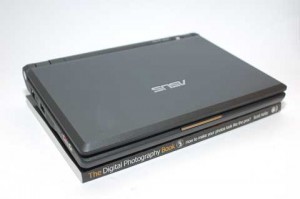ASUS Eee PC as a Cheap Guitar Rig
If you haven’t heard about the ASUS Eee PC already, it is basically a paperback sized, ultra-portable laptop, scaled down on features but offered at a price point that is almost irresistible. It comes in Linux and Windows versions, an on my digital photography website, Shuttertalk.com, I spent quite a bit of time looking at it to see if would be suitable as a photographer’s companion out and about.
I was excited then, to see people over at CDM doing the same thing in the digital music arena, to see if ASUS Eee PC can become a programmable, dedicated sound machine and synth.
“CDM reader Dan Stowell has put together a comprehensive tutorial on using SuperCollider, the powerful, free sound synthesis engine. You can even add custom GUIs using a free Java-based tool. There are also plenty of DIY environments for music working nicely (Csound and Pd included, as well), meaning the Eee can very quickly become a programmable, dedicated sound machine and synth for the price of the cheapest closed-box, name-brand piece of music gear.
The surprise is, full-blown Windows software holds its own. From the NI forums, a group of intrepid Guitar Rig 3 users have fired up XP and have a pretty usable, self-contained Guitar Rig computer”
One of my concerns pointed out in my review though, was that the screen size is a limiting factor – 800 x 480 pixels is quite small in todays standards. Many applications wouldn’t physically fit in the screen real estate, and led to a cumbersome experience.
I’m encouraged though, that many enthusiasts have been finding creative uses for the ASUS Eee PC for digital music – head over to CDM to so see what they have been up to.


I would’ve thought that latency would be an issue on patches, as the processor is not that powerful. I guess it depends on how ‘complex’ your patches are too, before you will notice anything.
I’ve heard of people running the Guitar Rig software on average spec’d notebooks before, where there was a latency between the time you hit the strings and the time you hear the sound produced through the speakers. Of course this is when you start to build up your patches with reverbs and other effects. The latency is in the order of milliseconds, but still enough to ruin the ‘feel’ of playing a real rig.
I can’t imagine Guitar Rig 3 would run smoothly, in its ‘high quality’ mode, on an Eee PC. LoQ would probably run. More ‘complex’ sounds like overdrives would benefit from HiQ mode though. Clean sounds are probably indistinguishable on either modes.
Great idea though and maybe with newer releases of the Eee PC with more grunt, it may be a gig-worthy option. Although by the time you buy an Eee PC + Guitar Rig 3, you could by a POD X3 Live :p
Now that you’ve mentioned the cost vs the POD X3 Live, it does put it in perspective. I’ve got a feeling though that for some, the urge to tinker is irresistible though.. 🙂
I’ve seen someone use a laptop rig in a church, and the guy was kind enough to let me have a test during their rehearsal, and yes, there was noticeable latency which took a lot of getting used to.
yeah….you do need a decent amount of processing power and RAM, to avoid latency issues.
People always wonder why there is latency with their laptops, when there isn’t with a multi-fx unit which have slower processors. The reason is that multi-fx units use DSP (Digital Signal Processing) chips, which are optimized processors for doing real time signal processing. Although they may have a slower clock cycle, they process real time signals more efficiently.
How did the laptop rig sound Ian? Was it direct to the PA?
Yup it was direct to PA, and the sound was quite useable but a little sterile for my liking. You also don’t get as good a feel of the dynamics of playing through a real tube amp, which has always been a criticism of digital modelling vs analog circuitry.
The tradeoff is that you don’t have to cart around 100kgs worth of amps & pedals to get a wide variety of sounds that still sound pretty good.